

Zitierweise / cite as:
Payer, Alois <1944 - >: Chronik Thailands = กาลานุกรมสยามประเทศไทย. -- Chronik 2010 / B. E. 2553. -- 1. undatiert. -- Fassung vom 2017-03-22. -- URL: http://www.payer.de/thailandchronik/chronik2010a.htm
Erstmals publiziert: 2013-04-16
Überarbeitungen: 2017-03-22 [Ergänzungen] ; 2016-12-31 [Ergänzungen] ; 2016-02-11 [Ergänzungen] ; 2015-06-05 [Ergänzungen] ; 2015-05-25 [Ergänzungen] ; 2014-10-22 [Ergänzungen] ; 2014-09-24 [Ergänzungen] ; 2014-09-11 [Ergänzungen] ; 2014-08-29 [Ergänzungen] ; 2014-03-23 [Ergänzungen] ; 2013-10-13 [Ergänzungen] ; 2013-05-02 [Ergänzungen] ; 2013-04-25 [Teilung des Jahrgangs] ; 2013-04-21 [Ergänzungen]
©opyright: Dieser Text steht der Allgemeinheit zur Verfügung. Eine Verwertung in Publikationen, die über übliche Zitate hinausgeht, bedarf der ausdrücklichen Genehmigung des Herausgebers.
Dieser Text ist Teil der Abteilung
Thailand von
Tüpfli's Global Village Library
ช้างตายทั้งตัวเอาใบบัวปิดไม่มิด
|
Gewidmet meiner lieben Frau Margarete Payer die seit unserem ersten Besuch in Thailand 1974 mit mir die Liebe zu den und die Sorge um die Bewohner Thailands teilt. |
|
Bei thailändischen Statistiken muss man mit allen Fehlerquellen rechnen, die in folgendem Werk beschrieben sind:
Die Statistikdiagramme geben also meistens eher qualitative als korrekte quantitative Beziehungen wieder.
|
| Statistik: Verkehrstote: 26.300 (d.h. 38 pro 100.000 Einwohner; Schweiz 4 pro 100.000, BRD 5 pro 100.000) Fläche der Kautschukplantagen: 2,6 Mio. Hektar Prozentsatz der von Viren verseuchten Computer: 70% (Weltspitze vor China: 60%) Thailändische Doktoranden in den USA: 223 Einwohner Phukets (ภูเก็ต) (offiziell): 525.000, davon 67.000 Billigst-Arbeiter aus Myanmar, Laos und Kambodscha und 49.000 sonstige Ausländer |
2010
Jahr des Tigers.
Abb.: Briefmarke "Jahr des Tigers", 2010
[Bildquelle: Tom Marshall. -- http://www.flickr.com/photos/atomdocs/4287259165/. -- Zugriff am 2012-03-14. -- Creative Commons Lizenz (Namensnennung, share alike)]
1905 - 2010
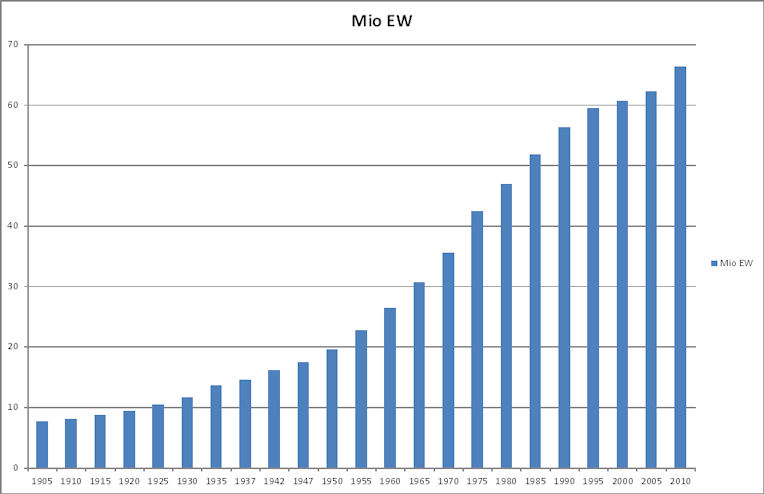
Abb.: Bevölkerung (in Mio. Einwohnern) 1905 bis 2010 (teilweise Schätzungen)
[Datenquelle: Pocket Thailand in figures 1996. -- Bangkok : Alpha Research,
1996. -- ISSN 0858-8297. -- S. 29.]

Abb.:
Bevölkerungsdichte (Einwohner je km²) 1910 - 2010
Datenquelle: Thailand in figures
2012-2013. -- Vol. 1. -- ISBN 978-616-7256-11-9]

Abb.:
Geburtenrate (Geburten pro 1000 Einwohner), 1970 - 2010
[Datenquelle:
Thailand in figures 2012-2013. -- Vol. 1. -- ISBN 978-616-7256-11-9. -- S.
88]

Abb.: Bevölkerungszunahme in % 2000 bis 2010
[Datenquelle: World Bank]
2010
Regionale Unterschiede: Anteil der Regionen an Bevölkerung, Bruttosozialprodukt (GDP), Öffentlichen Ausgaben
Abb.: Anteil der Regionen an Bevölkerung, Bruttosozialprodukt (GDP), Öffentlichen Ausgaben 2010
[Bildquelle: http://www-wds.worldbank.org/external/default/WDSContentServer/WDSP/IB/2012/06/20/000333038_20120620014639/Rendered/PDF/674860ESW0P1180019006020120RB0EDITS.pdf. -- Zugriff am 2013-01-27]
2010
Regionale Unterschiede: einige Indikatoren

Abb.:
Indikatoren regionaler Unterschiede 2010: Ärzte, Elektrizitätsverbrauch, neue
Motorräder
In Prozent von Gesamtthailand (= 100%)
Bei Gleichverteilung
müssten jeweils alle Säulen ungefähr gleich lang sein
[Datenquelle: Thailand in figures 2012-2013. -- Vol. 2. -- ISBN
978-616-7256-12-6. -- S. 27]
2010
Regionale Unterschiede: PCs und Internetanschlüsse

Abb.:
Regionale Unterschiede: PCs und Internetanschlüsse im Verhältnis zur Anzahl der
Haushalte (in Tausend) 2010
[Datenquelle: Thailand in figures 2012-2013. -- Vol. 1. -- ISBN
978-616-7256-11-9. -- S. 597]
2010
Beschäftigung nach Wirtschaftssektoren
Abb.: Beschäftigung von Frauen nach Wirtschaftssektoren 2010 (in Prozent)
Abb.: Beschäftigung von Männern nach Wirtschaftssektoren 2010 (in Prozent)
[Datenquelle für beide Grafiken: http://www.nationmaster.com/country-info/profiles/Thailand/Labor. -- Zugriff am 2014-03-23. -- Fair use]
2010
Beschäftigung von Hausangestellten
Abb.: Beschäftigung von Hausangestellten (in Prozent), 2009/10
[Datenquelle: Siroj Sorajjakool <1959 - >: Human trafficking in Thailand : current issues, trends, and the role of the Thai government. -- Chiang Mai : Silkworm, 2013. -- 241 S. : 21 cm. -- ISBN 978-616-215-060-9. -- S. 76.]Für die Pflege von Alterskranken ist das Monatsgehalt 5.500 bis 7.500 Baht, in Sonderfällen 8.000 bis 9.000 Baht. Für Feiertagsarbeit erhalten sie zusätzlich 300 - 500 Baht pro Tag.
2009 - 2011
Wichtigste Landwirtschaftsprodukte

Abb.:
Wichtigste Landwirtschaftsprodukte (Wert in Milliarden Baht) 2009/10 und 2010/11
[Datenquelle: Thailand in figures 2012-2013. -- Vol. 1. -- ISBN
978-616-7256-11-9. -- S. 339]

Abb.:
Kautschuk-Plantage, Phuket (ภูเก็ต),
2005
[Bildquelle: Lofor / Wikipedia. -- Public domain]
1975 - 2010
Zuckerrohranbau

Abb.:
Zuckerrohranbau (in Millionen Rai) 1975 - 2010
[Datenquelle: Thailand in figures 2012-2013. -- Vol. 1. -- ISBN
978-616-7256-11-9. -- S. 356]

Abb.:
Zuckerrohr-Ernte, bei Khon Kaen (ขอนแก่น),
2003
[Bildquelle: Gregory Lesturgez / Wikimedia. --
Creative Commons
Lizenz (Namensnennung)]
1982 - 2010
Ölpalmen (ปาล์มน้ำมัน, Elaeis guineensis Jacq.)

Abb.: Mit
Ölpalmen (ปาล์มน้ำมัน, Elaeis guineensis Jacq.) bepflanzte Fläche
(in Mio. Rai) 1982 - 2010
[Datenquelle: Thailand in figures 2012-2013. -- Vol. 1. -- ISBN
978-616-7256-11-9. -- S. 367]

Abb.:
Ölpalmen (ปาล์มน้ำมัน, Elaeis guineensis Jacq.) , Malaysia, 2007
[Bildquelle. Craig / Wikipedia. -- Public domain]
1991 - 2010
Erntefläche für Durian (ทุเรียน, Durio zibethinus L. ex Murr.)

Abb.:
Erntefläche für Durian (ทุเรียน, Durio zibethinus L. ex Murr.) (in
Tausend Rai) 1991/92 - 2010/11
[Datenquelle: Thailand in figures 2012-2013. -- Vol. 1. -- ISBN
978-616-7256-11-9. -- S. 377]

Abb.: Durian
(ทุเรียน, Durio zibethinus L. ex Murr.), Kho Phayam (เกาะพยาม), 2008
[Bildquelle: ed. h. --
http://www.flickr.com/photos/ear4/2386396877/. -- Zugriff am 2013-04-02. --
Creative Commons
Lizenz (Namensnennung, keine kommerzielle Nutzung, share alike)]
1991 - 2010
Erntefläche für Longan (ลำไย, Dimocarpus longan Lour.)

Abb.:
Erntefläche für Longan (ลำไย, Dimocarpus longan Lour.) (in Tausend Rai),
1991/91 - 2010/11
[Datenquelle: Thailand in figures 2012-2013. -- Vol. 1. -- ISBN
978-616-7256-11-9. -- S. 385]

Abb.: Longan-Ernte
(ลำไย, Dimocarpus longan Lour.), Ban Dong Pa Wai (บ้านดงป่าหวาย), 2007
[Bildquelel: Peter Richards. --
http://www.flickr.com/photos/doiboipete/2878626861/.
-- Zugriff am 2013-04-02. --
Creative Commons
Lizenz (Namensnennung, keine kommerzielle Nutzung, keine Bearbeitung)]
1997 - 2010
Erntefläche für Mangosteen (มังคุด, Garcinia mangostana L.)

Abb.:
Erntefläche für Mangosteen (มังคุด, Garcinia mangostana L.) (in Tausend Rai),
1997/98 - 2010/11
[Datenquelle: Thailand in figures 2012-2013. -- Vol. 1. -- ISBN
978-616-7256-11-9. -- S. 389]

Abb.:
Mangosteen (มังคุด, Garcinia mangostana L.)
[Bildquelle: Berthe Hoola van
Nooten (1817-1892) / Wikimedia. -- Public domain]
1985 - 2010
Erntefläche für Kaffee

Abb.:
Erntefläche für Kaffee (in Tausend Rai) 1985/86 - 2010/11
[Datenquelle: Thailand in figures 2012-2013. -- Vol. 1. -- ISBN
978-616-7256-11-9. -- S. 401]

Abb.:
Kaffeepflanzung, Provinz Chiang Mai (เชียงใหม่),
2012-11-30
[Bildquelle: Alois Payer. -- Public domain]

Abb.:
Kaffee-Anbaugebiete (Provinzen) (in Tausend Rai) 2010/11
[Datenquelle: Thailand in figures 2012-2013. -- Vol. 1. -- ISBN
978-616-7256-11-9. -- S. 401]

Abb.:
Wichtigste Kaffee-Anbau-Provinzen 2010/11
[Bildquelle: Wikipedia. -- Public
domain]
1992 - 2010
Wasserbüffel

Abb.:
Wasserbüffel (in Mio.) 1992 - 2010
[Datenquelle: Thailand in figures 2012-2013. -- Vol. 1. -- ISBN
978-616-7256-11-9. -- S. 414]
1987 - 2010
Milchkühe
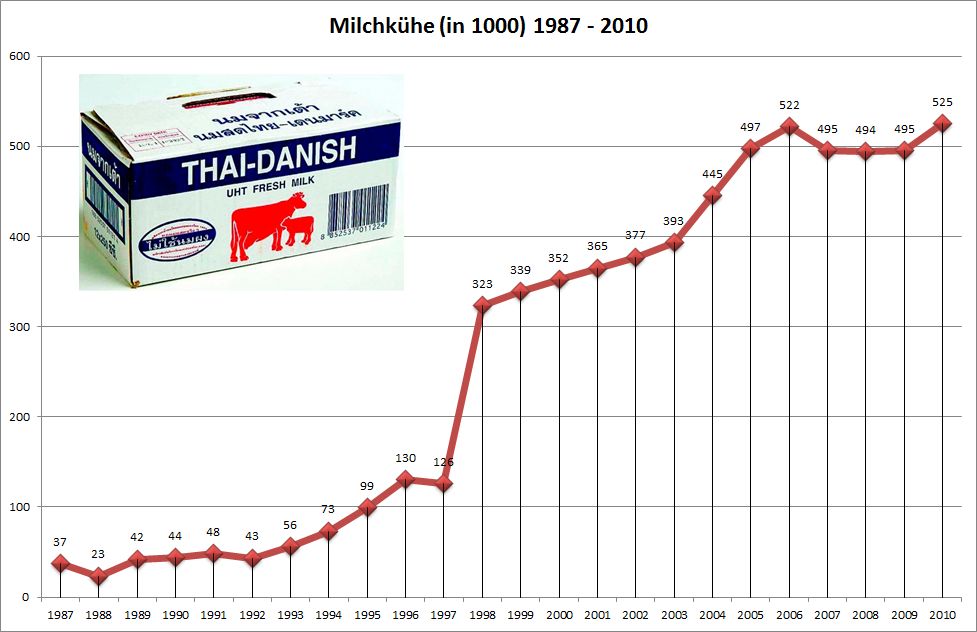
Abb.:
Milchkühe (in Tausend) 1987 - 2010
[Datenquelle: Thailand in figures 2012-2013. -- Vol. 1. -- ISBN
978-616-7256-11-9. -- S. 428]
1980 - 2010
Garnelenzucht (Shrimp farms)

Abb.: Shrimp
farms (in Tausend Rai) 1980 - 2010
[Datenquelle: Thailand in figures 2012-2013. -- Vol. 1. -- ISBN
978-616-7256-11-9. -- S. 435]

Abb.:
Durchlüftungswerk, Shrimp farm, Chanthaburi (จันทบุรี),
1999
[Bildquelle: autan. --
http://www.flickr.com/photos/autanex/308533701/.
-- Zugriff am 2013-04-03. --
Creative Commons
Lizenz (Namensnennung, keine kommerzielle Nutzung, keine Bearbeitung)]
2004 - 2010
Energieverbrauch (in Millionen Tonnen Öleinheit - Mtoe)

Abb.:
Energieverbrauch (in Millionen Tonnen Öleinheit - Mtoe) 2004 - 2010
[Datenquelle: Thailand in figures 2012-2013. -- Vol. 1. -- ISBN
978-616-7256-11-9. -- S. 236]

Abb.:
Elektrizitätsverbrauch (in 1000 Gigawattstunden) 2004 - 2010
[Datenquelle: Thailand in figures 2012-2013. -- Vol. 1. -- ISBN
978-616-7256-11-9. -- S. 236]

Abb.:
Elektrizitätsverbrauch pro Kopf (in 1000 kWh)
[Datenquelle: Thailand in figures
2012-2013. -- Vol. 1. -- ISBN 978-616-7256-11-9]

Abb.: Für das
Wohlbefinden wichtig, aber große Elektrizitätsfresser: Klimaanlagen, Bangkok,
2011
[Bildquelle: Zhu. --
http://www.flickr.com/photos/xiaozhuli/5409597571/.
-- Zugriff am 2013-04-01. --
Creative Commons Lizenz
(Namensnennung, keine kommerzielle Nutzung)]
2010
Energieverbrauch nach Wirtschaftssektor

Abb.:
Energieverbrauch nach Wirtschaftssektor (in Prozent) 2010
[Datenquelle: Thailand in figures 2012-2013. -- Vol. 1. -- ISBN
978-616-7256-11-9. -- S. 236]
1990 - 2010
Reisertrag pro Rai

Abb.:
Reisertrag (in kg) pro Rai bei einer Saat und bei zwei Saaten 1990/91 - 2010/11
[Datenquelle: Thailand in figures 2012-2013. -- Vol. 1. -- ISBN
978-616-7256-11-9. -- S. ]
2010
Big-Mac-Wirtschaftsindex:
Abb.: Big Mac Index 2010: Kosten eines Big Mac, aus der Landeswährung in US-Dollar umgerechnet
[Datenquelle: http://www.economist.com/node/16646178?story_id=16646178. -- Zugriff am 2013-10-13
2010
Größte Aktienbesitzer an der Stock Exchange of Thailand:
Rang Name Wert der Aktien in Milliarden Baht 1 Thongma Vijitpongpun
ทองมา วิจิตรพงศ์พันธุ์31.4 2 Keeree Karnjanapas
คีรี กาญจนพาสน์17.8 3 Anant Asavabhokhin
อนันต์ อัศวโภคิน.17.6 4 Prawit Maleenont
ประวิทย์ มาลีนนท์8.9 5 Worawit Weeraborwornpong
วรวิทย์ วีรบวรพงศ์8.8 6 Niti Osathanugrah
นิติ โอสถานุเคราะห์7.7 7 Viroj Thanalongkorn
วิโรจน์ ธนาลงกรณ์6.3 8 Prachum Maleenont
ประชุม มาลีนนท์6.1 9 Rattana Maleenont
รัตนา มาลีนนท์ 6.1 10 Uamporn Maleenont
เอื้อมพร มาลีนนท์6.1 [Datenquelle: Duangmanee Laovakul [ดวงมณี เลาวกุล]. -- In: Unequal Thailand : aspects of income, wealth and power / ed. by Pasuk Phongpaichit [ผาสุก พงษ์ไพจิตร, 1946 - ] and Chris Baker [1948 - ]. -- Singapore: NUS, 20116. -- 186 S. : Ill. ; 23 cm. -- ISBN 978-981-4722-00-1. -- Originaltitel: สู่สังคมไทยเสมอหน้า (2014). -- S. 38. -- Faire use]
1990 - 2010
HIV-Neuinfektionen:
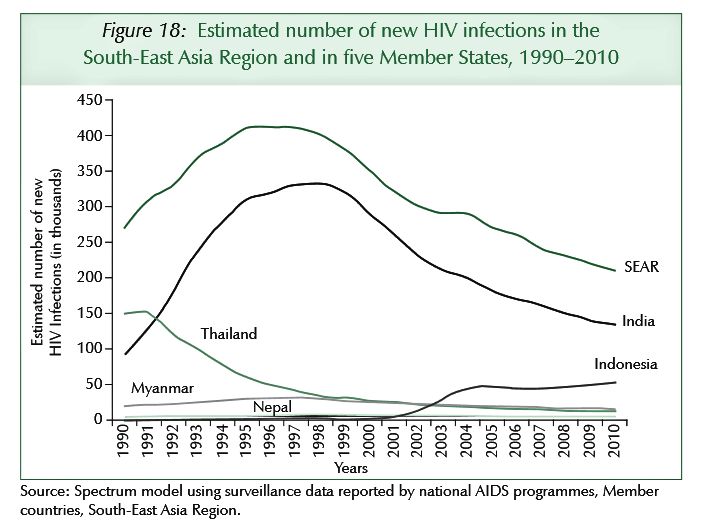
Abb.: Geschätzte
Neuinfektionen mit HIV 1990 - 2010
[Bildquelle:
http://whothailand.healthrepository.org/bitstream/123456789/1430/1/2012%20Report--Tuberculosis%20Control%20in%20SE%20Asia%20Region.pdf.
-- Zugriff am 2013-03-18]
|
"Thailand is classified by WHO as one of the 22
countries in the world with the highest TB burden. With a population of nearly
67 million,
[Quelle: http://www.whothailand.org/en/Section3/Section129.htm. -- Zugriff am 2013-03-13
|
2004 - 2010
Tuberkulose:

Abb.:
Tuberkulose in Thailand 2004 - 2010
[Bildquelle:
http://whothailand.healthrepository.org/bitstream/123456789/1430/1/2012%20Report--Tuberculosis%20Control%20in%20SE%20Asia%20Region.pdf.
-- Zugriff am 2013-03-18

Abb.: Kennzahlen
zur Tuberkulose in Thailand 2010
[Bildquelle:
http://whothailand.healthrepository.org/bitstream/123456789/1430/1/2012%20Report--Tuberculosis%20Control%20in%20SE%20Asia%20Region.pdf.
-- Zugriff am 2013-03-18]
2002 - 2011
Ausländische Patienten in Thai-Krankenhäusern
Abb.: Ausländische Patienten in Thai-Krankenhäusern, 2002 - 2011 (in Tausend)
[Datenquelle: http://www.boi.go.th/tir/issue/201203_22_3/42.htm. -- Zugriff am 2014-09-24]
Haushaltsjahr 2010/2011
Transferleistungen zwischen Regierungsstellen
Abb.: Transferleistungen zwischen Regierungsstellen (in Mio. Baht), Haushaltsjahr 2010/2011
[Bildquelle: http://www-wds.worldbank.org/external/default/WDSContentServer/WDSP/IB/2012/06/20/000333038_20120620014639/Rendered/PDF/674860ESW0P1180019006020120RB0EDITS.pdf. -- Zugriff am 2013-01-27]
2010
Wie die Zusammenarbeit zwischen Zentralregierung und Ortsbehörden tatsächlich funktioniert
[Bildquelle: http://www-wds.worldbank.org/external/default/WDSContentServer/WDSP/IB/2012/06/20/000333038_20120620014639/Rendered/PDF/674860ESW0P1180019006020120RB0EDITS.pdf. -- Zugriff am 2013-01-27]
2010
UNDP Income Index 2010

Abb.: UNDP
Income Index 2010
[Bildquelle: bangkokpundit. --
http://www.flickr.com/photos/60433209@N00/4682792006/in/photostream. --
Zugriff am 2013-02-28. --
Creative Commons
Lizenz (Namensnennung, keine kommerzielle Nutzung, share alike)]
2010

"Auslandschinesen":
Abb.: Personen mit chinesischem Migrationshintergrund 2010
[Datenquelle: manager magazin. -- 3 (2012), S. 87]
Abb.: Religiöses Zentrum der Thai-Chinesen: Wat Mangkon Kamalawat (วัดมังกรกมลาวาส - 龍蓮寺), Bangkok
[Bildquelle: Alan Oscroft / Wikimedia. -- Public domain]
Abb.: Lage des Wat Mangkon Kamalawat (วัดมังกรกมลาวาส - 龍蓮寺)
[Bildquelle: OpenStreetMap. -- Creative Commons Lizenz (Namensnennung, share alike)]
1988 - 2010
Militärausgaben:
Abb.: Militärausgaben 1988 - 2010 in Milliarden Baht (blau) und in Promille des Bruttosozialprodukts (rot).
[Datenquelle: SIPRI]
Abb.: yo sahassaṃ sahassena
saṅgāme mānuse jine |
ekaṃ ca jeyya m' attānaṃ
sa ve saṅgāmajuttamo ||"Mag jemand im Kampf Tausende von Menschen besiegen,
[ein anderer] besiegt nur sich selbst: dieser zweite ist der größte Sieger im Kampf." (Dhammapada 103)
Wandmalerei, Pai (ปาย), Provinz Mae Hongson (แม่ฮ่องสอน), 2007
[Bildquelle: Jean Pierre Candelier. -- http://www.flickr.com/photos/jpcandelier/490308210/. -- Zugriff am 2012-03-14. -- Creative Commons Lizenz (Namensnennung, keine kommerzielle Nutzung, share alike)]
Abb.: Lage von Pai (ปาย)
[Bildquelle: OpenStreetMap. -- Creative Commons Lizenz (Namensnennung, share alike)]
1950-2010
Die wichtigsten Rüstungsexporteure nach Thailand (kumuliert 1950 bis 2010) (in festen Preisen 1990):
Abb.: Die wichtigsten Rüstungsexporteure nach Thailand (kumuliert 1950 bis 2010) (in Mio. US-$ zu festen Preisen 1990) [Datenquelle: SIPRI]
Abb.: Wichtigster Rüstungslieferant: USA
[Bildquelle: CIA. -- Public domain]
Abb.: Wichtigste Rüstungsexporteure nach Thailand, außer USA
[Bildquelle: CIA. -- Public domain]
Abb.: "GULF OF THAILAND (May 8, 2011) 2nd Lt. Robert McCartney, Weapons Platoon Commander, Landing Force Company assists Royal Thai Navy Lt. Cmdr. Pongsapae Thongsook with his rifle during a live-fire range aboard the USS Tortuga (LSD 46). Tortuga and its embarked Marines are participating in Cooperation Afloat Readiness and Training, a bilateral exercise that enhances regional cooperation, promotes understanding and builds trust between participating military forces."
[Bildquelle: U.S. Marine Corps Photo by Cpl. Aaron Hostutler. -- http://www.flickr.com/photos/compacflt/5710141583/. -- Zugriff am 2012-02-27. -- Creative Commons Lizenz (Namensnennung, keine kommerzielle Nutzung)]
1995 - 2010
Morde pro 100.000 Einwohner, Vergleich Thailand und Deutschland
Abb.: Morde pro 100.000 Einwohner, Vergleich Thailand und Deutschland, 1995 - 2010
[Datenquelle: http://en.wikipedia.org/wiki/List_of_countries_by_intentional_homicide_rate_to_1999 und http://en.wikipedia.org/wiki/List_of_countries_by_intentional_homicide_rate. -- Zugriff am 2011-12-14]
1960 - 2010
Wechselkurse Baht - US-$
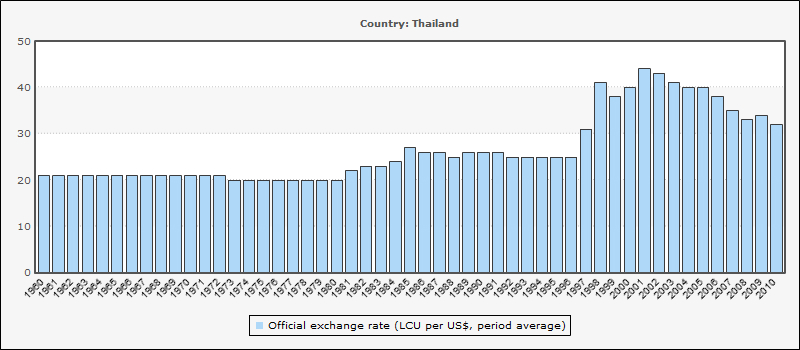
Abb.: Wechselkurse Baht pro US-$, 1960 - 2010
[Datenquelle: World Bank. -- Zugriff am 2011-12-12]
2002 - 2010
Entwicklung der Presse-Unfreiheit
Abb.: Entwicklung der Presse-Unfreiheit in Thailand: Press Freedom Index von 2002 - 2010 für Thailand und das jeweils unfreiste Land
[Datenquelle: Reporters without Borders]
Rangordnung der Länder (1 = Land mit größter Pressefreiheit) Jahr Thailand Rang des Landes mit der geringsten Pressefreiheit 2002 65 139 2003 82 166 2004 59 167 2005 107 167 2006 122 168 2007 135 169 2008 124 173 2009 130 175 2010 153 178 Press Freedom Index 2002 - 2010
[Datenquelle: Reporters without Borders]
2010
Eine nächtliche Überprüfung durch die Polizei ergibt, dass in Phuket (ภูเก็ต) weniger als 25% der Motorradfahrer jemals den vorgeschriebenen Sicherheitshelm tragen.
Abb.: Motorradfahrerinnen Phuket 2013
[Bildquelle: Alexander Baranov. -- http://www.flickr.com/photos/alexbaranov/8501880222/. -- Zugriff am 2015-02-26. -- Creative Commonbs Lizenz (Namensnennung)]
2010
Filme mit dem größten Umsatz (Kassenschlager)
| 1 | Harry Potter and the Deathly Hallows (Part One) | $4,9 Mio. |
| 2 | Iron Man 2 | $4,6 Mio. |
| 3 | Kuan Mun Ho (กวน มึน โฮ - Knowing Me, Knowing You) | $4,4 Mio. |
| 4 | Sudkhet Saletped (สุดเขต สเลดเป็ด) | $4,1 Mio. |
| 5 | Resident Evil: Afterlife | $3,4 Mio. |
[Datenquelle: Box Office Mojo]
 Platz 1 |
 Platz 2 |
 Platz 3 |
 Platz 4 |
 Platz 4 |
Kassenschlager 2010 [Quelle der Bilder: Wikipedia. -- Fair use] |
2010
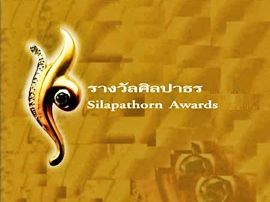
Den Silpathorn Award (รางวัลศิลปาธร) erhalten:
- Visual Arts: Navin Rawanchaikul (นาวิน ลาวัลย์ชัยกุล, 1971 - )
- Literature: Saneh Sangsuk (เสน่ห์ สังข์สุข = แดนอรัญ แสงทอง, 1957 - )
Music: Chaiyoot Tosa-nga (ชัยยุทธ โตสง่า = ป๋อม บอยไทย - Pom Boy Thai)
Künstlerlink auf Spotify:
URI: spotify:artist:2XlH6v1xzE8FDc67JGZp38
URL: https://open.spotify.com/artist/2XlH6v1xzE8FDc67JGZp38- Film: Aditya Assarat (อาทิตย์ อัสสรัตน์, 1972 - )
- Performing Arts: Nikorn Saetang (นิกร แซ่ตั้ง)
- Design: Withoon Khunalangkan (วิฑูรย์ คุณาลังการ) (interior design)
- Design: Pracha Suveeranont (ประชา สุวีรานนท์) (graphic design)
- Design: Wasinburi Supanichwarapat (วศินบุรี สุพานิชวรภาชน์, 1971 - ) (design; Keramiker)
- Architecture: Patama Roonrakwit (ปฐมา หรุ่นรักวิทย์)
Abb.: Plakat für einen Film von Navin Rawanchaikul (นาวิน ลาวัลย์ชัยกุล)
[Fair use]
Abb.: Einbandtitel eines Buchs von Saneh Sangsuk (เสน่ห์ สังข์สุข = แดนอรัญ แสงทอง)
[Fair use]
Abb.: CD-Titel von Chaiyoot Tosa-nga (ชัยยุทธ โตสง่า = ป๋อม บอยไทย - Pom Boy Thai)
[Fair use]
Abb.: Plakat eines Films von Aditya Assarat (อาทิตย์ อัสสรัตน์)
[Fair use]
Abb.: Von Nikorn Saetang (นิกร แซ่ตั้ง) geleitete Theatergruppe
[Fair use]
Abb.: Plakat einer Ausstellung von Pracha Suveeranont (ประชา สุวีรานนท์)
[Fair use]
Abb.: Plakat für eine Veranstaltung mit Wasinburi Supanichwarapat (วศินบุรี สุพานิชวรภาชน์)
[Fair use]
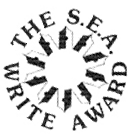
Zakariya Amataya (ซะการีย์ยา อมตยา, 1975 - ) erhält den Southeast Asian Writers Award für die Gedichtsammlung ไม่มีหญิงสาวในบทกวี
Abb.: Einbandtitel
2010
Sirirat Ruangsri (สิริรัตน์ เรืองศรี, 1988 - ) wird Miss Thailand World 2010

Abb.: Sirirat
Rueangsri (สิริรัตน์ เรืองศรี)
[Bildquelle: Jakkaphan Sanitprem. --
http://www.flickr.com/photos/jakkaphan/6989812228/.
-- Zugriff am 2013-04-21. --
Creative Commons Lizenz
(Namensnennung, keine Bearbeitung)]
2010
Der erfolgreiche Luk Thung (ลูกทุ่ง) Komponist Sala Khunawut (สลา คุณวุฒิ aka ครูโบ้, 1962 - ) erhält den Grammy Diamond Song Award für "Best Thai Composition for Luk Thung Lyrics"
Künstlerlink auf Spotify:
URI:
spotify:artist:2L20gXon9gTrB4nXG74mrv
URL:
https://open.spotify.com/artist/2L20gXon9gTrB4nXG74mrv

Abb.:
CD-Titel
[Fair use]
2010
Gründung des Jugendorchesters Siam Sinfonietta
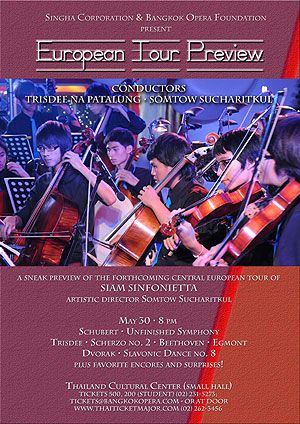
Abb.: Plakat
|
"Siam Sinfonietta is a youth orchestra founded in 2010 by Thai/American composer Somtow Sucharitkul (สมเถา สุจริตกุล, 1952 - ), Thai conductor Trisdee na Patalung (ทฤษฎี ณ พัทลุง, 1986 - ), and the Bangkok Opera (บางกอกโอเปร่า) Foundation. It was created in order to provide intensive training for young Thai musicians intending to have a serious career in classical music. The orchestra operates out of the offices of the Bangkok Opera Foundation. The orchestra came into existence at the first "Bach to the Future: Science through Music" camp[1] and immediately embarked on a series of concerts in Bangkok, particularly concerts for young audiences and concerts that serve to introduce classical music to new audiences. It has toured extensively in Thailand and in its second year plans more international touring as well. Some high-profile events the Siam Sinfonietta has participated in include the "Together We Can" concert to raise awareness of the governor of Bangkok's initiative for reconciliation after the 2010 unrest in downtown Bangkok,[2] and the "Introducing the Symphony" series at Bangkok's Art and Culture Center (หอศิลปวัฒนธรรมแห่งกรุงเทพมหานคร), populist concert-lectures about music.[3] The orchestra holds annual auditions and has an entry age of 12, with the cutoff for membership set at 25. A number of its members are also members of full-fledged professional orchestras such as the Siam Philharmonic Orchestra," and the Bangkok Symphony Orchestra. It has twice performed in conjunction with the Siam Philharmonic Orchestra: in the Thailand premiere of Mahler's Third Symphony, and at a gala concert in front of Central World (เซ็นทรัลเวิลด์) in Rajprasong (ราชประสงค์), Bangkok, the site of the 2010 troubles, as part of an event to promote "Healing through Harmony." The Sinfonietta receives its funding largely from government grants and private and corporate sponsorship. On July 8, 2012, the two-year-old orchestra won first place at the Summa Cum Laude International Youth Music Festival in the symphony orchestra category." [Quelle: http://en.wikipedia.org/wiki/Siam_Sinfonietta. -- Zugriff am 2013-04-09] |
2010

Es erscheint
Junya Yimprasert [จรรยา เล็ก ยิ้มประเสริฐ]: Why I don’t love the King?. -- 2010. --http://www.globallabour.info/en/2010/06/why_i_dont_love_the_king_by_ju.html. -- Zugriff am 2014-10-22. -- "Junya Yimprasert is the director of the Thai Labour Campaign, a labour support NGO, and the leader of the Migrant Workers' Union of Thailand."
Auszüge:
"All people have their limits and I write this letter to let people know why I don’t love the King.
Born to love the King and QueenOld pictures of the young and beautiful King and Queen, and of the prince and princesses, were always on the empty wall of our family’s house. No matter how many times we had to build or rebuild our home, these pictures were always with us, and always returned to the highest spot of the wall. They were still there on the empty wall when I last visited my home, colours faded and stained at the corners by rain drops.
As soon as I could open my eyes I saw the picture of the King, as soon as I could understand a few words I was told that we must love the King and Queen because they are our King and Queen.
We were made to believe they are the greatest of all Kings and Queens, and in those days TV was saturated with programmes about royal projects and charities to prove it. No one in my family had ever met the King, but we all loved the King because everyone said he is a good King.
When I was very small we used to go to the neighbours to watch TV. My grandmother and mother were addicted to the regular 8 pm news about the Royal Family. Making sure they watched the royal news was part of their code of practice for being a proper citizen. When the Government said light a candle for the King they did so without question, and they really did love the handsome King and the beautiful Queen, the young prince and the princesses, and never stopped commenting on how graceful they looked. Nevertheless, as small children we couldn’t wait for the royal programmes to pass, so we could continue watching the regular Thai soap-operas.
My village is an old, collective, rice-farming village of around 200 households. In the 1960s into the 1980s it was a very lively village. Everyone knew everyone and half the village were relatives. Almost everyone participated in everyone else’s household ceremonies - from birth to death.
For nearly half the year our village was flooded and many houses were linked by shared, raised, wooden walkways. For us small children it was easy and fun to skip along from house to house without having to negotiate ladders. We could enter everyone’s kitchen with ease and see what food they had, and we would eat together according to each other’s ideas about how and what to cook. But usually there was not much, just rice, noodles, chillies, vegetables and fish. Because of the floods few houses in our village kept chickens. We had to buy almost everything on credit, and I don’t remember having a whole egg just for myself before I entered secondary school.[...]
My village is 100 kilometres from Bangkok, but hundreds of kilometres away, up in the northeast, the same developments came later.
After the grain was sold and villagers had a bit of money, lines of vendors with baskets of this and that on their shoulders would pass through the village. Many walked from village to village selling all kinds of goods; mosquitoes nets, pots, pans and blankets - and pictures of the Royal Family.
I remember when my Grandma bought pictures of the King and the Queen, each in a flaming, gold-painted frame, and hung them with great pride in the high spot of her house. And I remember how my Mum was down-hearted because we couldn’t afford to buy our own.
This is how I loved my village and how we ‘loved’ the King and Queen, long before I was able to think about the meaning of love.Our love for the Royal Family was an unquestioning love, a tiny part of the great ‘capital of love’ that the Thai King and Queen have been so privileged to receive from the Thai people, and become accustomed to taking for granted - as if it were their divine right.
[...]
When the Government promoted the Queen to be the ‘Mother of the Nation’, just before the bloody, military crackdown in 1976, I was unable to think of her as a mother. The Queen was the Queen, but my Mum was the greatest woman in my life. This doesn’t mean I didn’t admire the Queen in all her glamorous dresses and jewellery. The media had long been attempting to proclaim her the most beautiful queen in the world and, since we had never seen any other queen, we had all come to believe that she was.
Well, surely it is not just me that thinks my own mum is the greatest mum in the world.
Communists will eat your liver and burn you alive![...]
I managed also to pass the examination to enter the famous Silpakorn University. A couple of months into my first semester at Silpakorn I had to go to Bangkok to receive my King’s Award. A senior teacher and my mother were to accompany me to the Palace and I was to receive the award from Princess Sirindhorn, the Crown Princess. My mother and the high-school were highly excited.
The teacher, my mother, one sister and I came together in Bangkok, at some Ministry of Education building, where we spent a full day practicing how to appear before a member of the Royal Family.
All went well with the ceremony. My school took my certificate and hung it on the wall of the Rector’s Room, still the only such certificate to be awarded a child from my District Secondary. I received 2,000 Baht in a gold-coloured box, and my mother a picture of the Princess handing me the box. The picture was hung on our big empty wall for the neighbours and visitors. The box still sleeps in the wardrobe.
[...]
No wonder the educated classes are the most royalist and most cruel, and most unable to identify and correct their own fallacies. No wonder they stand behind the military against their own people and encourage their Prime Minister to use live ammunition against the lower classes that dare set foot in their precious shopping centres.
I was told recently that I don't love the country, don't have faith in any Thai institutions and that I am not justified to call myself a Thai etc.
Thailand’s so-called educated classes are making the mistake of linking the legitimate struggle of the poor for democracy and justice with not loving the King and ‘anti-monarchy’. This is a serious, tragic and extremely dangerous mistake - the result of an education system that is deprived of good human reason.
[...]
All were accorded amnesty. This is the customary practice in Thailand for solving political conflict - to seek, over the bodies of a few dead citizens, the forgiveness of the King. The King’s word is the justice and that’s it - no more talk of justice. The general that commanded the military that killed 48 people was pardoned and allowed to continue to live in luxury. Like all our previous tyrants, before and after, he, nor anyone else, was ever taken to a court of justice.
I began to feel seriously disturbed. Far, far behind time the people of Thailand were pleading, once again, for participatory democracy, and what did they receive? 48 murdered working class heroes and a royalist Prime Minister appointed by the King (not just once but twice) - a CEO from the clothing business with a long record of union-busting. He was welcomed by middle-class academics and royalist NGOs. 1992 was yet another juncture in the institutionalisation of political corruption.[...]
Instead of trying to listen to their critics, the royalist Government and Palace institutions attempt to shut them down.
When I look at Thailand as a Thai and visit countries which retain a monarchy, and when I reflect on the situation in Nepal, I cannot but feel amazed that the Thai royals do not learn from these examples.
I remember one dinner in a small restaurant in Oslo. A woman was leaving the restaurant and my friend said: “She’s a princess”. The woman drove herself away alone, nobody followed her. And again on a walk with friends I found myself in a beautiful garden. What a surprise, I was standing in a garden of the residential Palace with not a soldier in sight.
In Copenhagen I was walking with a friend past the Palace gate when the Crown Prince drove out, followed by one car. There was no road block to clear the traffic for his passage.
In Thailand, when members of the Royal Family are on the move, in Bangkok or to some royal destination like Chiang Mai, streets and foot-bridges are cleared by police for 10 minutes or even 30 minutes before the fleet of royal cars comes streaking through at twice the speed limit, a law unto themselves. We used to count how many cars. A convoy of 30 expensive cars, all the same colour, is quite usual for senior members of the Thai Royal Family.Take the story of Bouquet in July 2009, a 6-year-old who died because she was delayed one hour by a royal road block on her way to hospital, because a member of the royal family was visiting a Spa. The father requested that the soldiers inform the princess that his daughter was very sick. His call was refused so he detoured to another road and found that blocked too. As his daughter lay dying in hospital, he wrote to the Samesky web-board. We all prayed for Bouquet but, as her father said, “She died so that a ‘singer’ could go to the spa”.
[...]
In May 2009 the commander of an infantry division that died in the crackdown on red-shirt protesters on April 10 was also given a royal cremation, attended by the Queen and Crown Prince. The wife of the dead soldier was made an Advisor to the Prime Minister. The families of the 88 protesters who died were granted 50 000 Baht (1 200 Euro) by the Palace etc.
Where is there any justice in all of this? There is no justice in any of it.[...]
Why does the Palace refuse to allow open discussion of how the Thai see the role of their beloved Monarch? Could it be that the Palace itself is so sunk in scandal that it is afraid to open the doors?
The fear of communism that pushed the Thai Royal Family into becoming strong allies with corrupt generals is understandable. Why Thailand fell into the USA’s anti-communist war is well known.
Why the Royal Family befriended tyrants like Marshal Thanom, and why they helped him and others avoid criminal charges and provided them with soft beds and royal cremations is also understandable.
Why the Royal Family did not support Pridi Phanomyong, the father of Thai democracy, why in 1947 the Royal Family supported the general that kicked him out, why the Royal Family did not pardon Pridi, why the royal family did not allow him to return home as an old man, even if only to console his family - is not understandable.
[...]
In Spain transition to democracy during the late 70s (after decades of dictatorship under General Franco that began in 1939 and ended with his death in 1975) was generating considerable animosity within the Spanish armed forces. This culminated in an attempted military coup on 23 February 1981. The coup was thwarted by an unambiguous television broadcast by King Juan Carlos, in the uniform of the Supreme Commander of the Spanish armed forces. He called on the public to support their legitimately elected Government. The leader of the coup was sentenced to 30 years in jail. The King’s action led to a strengthening of Spanish democracy and to renewed respect for the monarchy.
In contrast, since 1947 the King of Thailand has personally approved 7 successful military coups.
At any time during the last 60 years the Royal Household of Thailand could have stood-up for the people’s struggle for democracy and ended Thailand’s endless string of military coups and violent crackdowns.
The violent crackdown by the Royal Thai Army on the people in April 2010 has pushed Thailand further down the slippery road to the ignoble status of ‘failed state’.
It is long past time for the Thai to engage in wide-open public debate on the role of Thai royals, their Palace institutions and the huge military force they command, and on the problems that emerge from their absolute powers and extremely expensive absolute privileges, that absolutely do not promote the ‘sufficiency economy’ promoted by the King himself.
By opening real space for public criticism, the Royal Family could still rescue itself and become a real player in the work of preventing further domestic violence and bringing internal justice to Thailand - without the use of the military or para-military gangs, who can have no role in the civilian life of a country like Thailand in the 21st century.
The Palace must allow all Thai people to freely air their feelings on what they feel about their monarchy and the Palace must order an end to the ‘Love the King’ and ‘Protect the Monarchy’ propaganda.
From the day I was born the Royal Family had my love, but slowly they have been losing that love. If the Palace makes me choose between loving the Royal Family and loving the Thai people I can only choose the latter. Nothing and nobody can compete with my love for the people of Thailand.
When it comes to the institutions of monarchy there are issues that the public must be able to debate, without fear of years in prison, for example:
v The wealth of the Thai King has been increasing steadily for the last 60 years. With property worth 35 billion USD, in 2008 Forbes anointed the Thai King with the title of Richest Monarch in the World. With the glaring gap between rich and poor in Thailand, the Thai public must be allowed to analyse and discuss the vast wealth of their monarchy .
v During the last 20 years the Palace Budget has been increased 20 times, from 3 million Euro (141 million Baht) to 65 million Euro (2.6 billion Baht). (Note: The poor English Queen has hardly seen a rise in her Palace Budget in 20 years and has to manage with a meagre 8 million Euro.)
v The use of the 150 million Euro (6 billion Baht) that is paid-out annually from the State Budget to finance Thailand’s ‘Royal Projects’ must be subjected to public scrutiny, debate and evaluation.
v Article 112 of the Thai Criminal Code that covers Lèse Majesté must be removed for the good of the nation and of the monarchy.
v The Privy Council’s ability to intervene in Thai politics must be outlawed.
v The Thai people do not need 60 military units with over 30,000 soldiers to guard a monarchy that claims all people love the Monarch.
[...]
v It is nothing less than sickening to witness that every time ordinary people attend meetings to bring worker’s and villager’s problems to the attention of the authorities their mouths are shut with statements from the authorities like: ‘I am the servant of the King. I work for the King’. Such phrases are used by the authorities as a spiteful weapon to suppress the development of the people, the authorities that the people pay to serve them – not the King, who has more than enough servants. Use of such statements by municipal and government authorities prevents real discussion of real, necessary and urgent issues, and must be banned.
v Many grass-root environment protection groups and local community development programmes point-out that if a project does not have a sign saying ‘This project is under the patronage of this or that member of the Royal Family’ they will not receive the co-operation of government officers, not to mention financial support.
[...]
v There are many other established, royal practices and customs that need to be reviewed and largely eradicated e.g. the Royal Family’s expectation that public money will be used to block roads for their convoys of shiny cars; that people who go to a Charlie Chaplin movie must stand to bless the King before it starts; that millions of Baht from much needed local budgets must be spent on building temporary palaces for visiting royals; that when they meet the King or Queen they must crawl before their feet and recite some hocus pocus like: "May the power of the dust on the soles and the dust under the soles of your royal feet protect my head and the top of my head."
ใต้ฝ่าละอองธุลีพระบาทปกเกล้าปกกระหม่อม
‘Tai-Fa-La-Ong-Thu-Lee-Pra-Bart-Pok-Klao-Pok-Karmom.’No person on this planet today is dust under the feet of any other person. Even the great Lord Buddha gave up his kingdom to be equal with everyone else.
These are some of the reasons that make it difficult for me to love the King.
The current ‘Protect the Monarchy’ mobilisation for a ‘Sufficiency Economy’ is leading us to civil war not peace. When will the monarchy and it’s institutions be kind enough to accept, welcome and support our struggle for equal rights, justice, democracy, the results of free and fair elections and our basic rights of Freedom of Expression and Freedom of Association?"
[a.a.O. -- Fair use]
2010

Es erscheint
Anderson, Wanni W. (Wanni Wibulswasdi) <1937 - >: Mapping Thai Muslims : community dynamics and change on the Andaman Coast. -- Chiang Mai : Silkworm, 2010. -- 185 S. : Ill. ; 21 cm. -- ISBN 9789749511923.
Abb.: Einbandtitel
"On the broader issue of relations between the Thai government and Thai Muslims, the Nipa islanders actually shared some of the insurgents’ concerns. Danai expressed the following candid view: There exists a sad gap in the understanding of Islam and of Muslims by many Thai government officials.
One time at a meeting a government official who tried to be cognizant of Islam made a statement about Muslims going on the hajj to krap wai [ครับไหว้] [worship] the Ka’aba [الكعبة]. I was so perturbed that I raised my hand and corrected him, saying we don’t worship the Ka’aba. It is simply a directional artifice to indicate the direction we are supposed face when we conduct the five daily prayers.
In another instance, in the aftermath of the December [2004] tsunami, a lot of clothing and food was sent to Krabi [กระบี่]. Some were sent to Nipa Island and we appreciated the thoughtfulness. But, among the food sent were pork-flavored Mama package noodles! They should have known that we don’t eat pork!
We’d like to see more chai kwang [ใจกว้าง], that is, a more broad-minded acceptance of our Muslim lifeways. I think that Buddhist-Muslim relations would benefit from more mutual respect for each other and a better understanding of what Islam is all about."
[Quelle: Anderson, Wanni W. (Wanni Wibulswasdi) <1937 - >: Mapping Thai Muslims : community dynamics and change on the Andaman Coast. -- Chiang Mai : Silkworm, 2010. -- 185 S. : Ill. ; 21 cm. -- ISBN 9789749511923. -- S. 148. -- Fair use]
2010

Es erscheint die erste Nummer der elektronischen Zeitschrift
buddha magic / hrsg von Spencer Littlewoods. -- erhältlich bei http://thailand-amulets.net/. -- Zugriff am 2013-02-01
Damit gibt es ein englischsprachiges Periodikum zu den für viele Thais so wichtigen Gebieten wundertätige Mönche, Amulette und Magie.
Abb.: Titelblatt von Nr. 1
2010

In Thailand werden 1,6 Mio. Autos produziert (= 60% Zunahme gegenüber 2009). Davon geht mehr als die Hälfte in den Export. Japanische Hersteller (Toyota, Honda, Mitsubishi, Nissan) produzieren in Thailand besonders für den japanischen Markt.
Abb.: Toyota-Fabrik, Samut Prakan (สมุทรปราการ)
[©Google earth. -- Zugriff am 2012-10-11]
2010
Schaffung der Internet-Top-Level-Domain .ไทย
2010

Mönche und Novizen 2010.
Abb.: Anzahl der Mönche und Novizen 2010
Mahānikāya Dhammayutikanikāya Mönche Novizen Mönche Novizen Bangkok 14.304 3.369 1.625 901 Zentralthailand 88.367 9.857 4.730 2.242 Nordthailand 49.635 23.061 2.704 546 Nordostthailand 92.782 22.188 19.152 5.175 Südthailand 16.378 2.772 1.439 297 Total
261.466 61.247 29.650 9.161 [Datenquelle: Source: The Religious Affairs Department, Ministry of Education]
Abb.: Diplomierte Mönche, Sawankhalok (สวรรคโลก), Provinz Sukhothai (สุโขทัย), 2008
[Bildquelle: Tevaprapas Makklay / Wikimedia. -- Creative Commons Lizenz (Namensnennung)]
Abb.: Lage von Sawankhalok (สวรรคโลก)
[Bildquelle: OpenStreetMap. -- Creative Commons Lizenz (Namensnennung, share alike)]
2010

Fertigstellung des 45 m hohen "Giant Buddha" (Phra Puttamingmongkol Akenakkiri) auf dem Nakkerd Hill in Phuket (ภูเก็ต). Baukosten: 30 Mio. Baht.
Abb.: Lage von Phuket (ภูเก็ต)
[Bildquelle: OpenStreetMap. -- Creative Commons Lizenz (Namensnennung, share alike)]
Abb.: "Giant Buddha" (Phra Puttamingmongkol Akenakkiri), Phuket (ภูเก็ต), 2008
[Bildquelle: Eustaquio Santimano. -- http://www.flickr.com/photos/eustaquio/3094639419/. -- Zugriff am 2012-05-03. -- Creative Commons Lizenz (Namensnennung, keine kommerzielle Nutzung, keine Bearbeitung)]
2010
Fluggäste der Flughäfen außer Suvarnabhumi (Suvarnabhumi - สุวรรณภูมิ hat 2010 42,8 Mio. Fluggäste.):
Abb.: Passagiere der Flughäfen außer Suvarnabhumi, 2010
[Datenquelle: http://en.wikipedia.org/wiki/Busiest_airports_in_Thailand. -- Zugriff am 201204-04]
Abb.: Lage der Flughäfen
[Bildquelle: CIA. -- Public domain]
Abb.: Flughafen Phuket (ท่าอากาศยานนานาชาติภูเก็ต)
[Bildquelle: ©Google earth. -- Zugriff am 2012-04-04]
2010
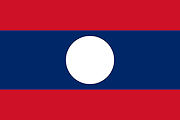
Beginn des Baus der Fourth Thai–Lao Friendship Bridge (สะพานมิตรภาพ ไทย-ลาว แห่งที่ 4 - ຂົວມິດຕະພາບລາວ - ໄທ ແຫ່ງທີ 4) zwischen Chiang Khong (เชียงของ) und Ban Houayxay (ຫ້ວຍ ຊາຍ, Laos). In der Nähe des Brückenkopfs sind schon 70% der Grundstücke an Ausländer (Chinesen) verkauft.
Abb.: Lage von Ban Houayxay (ຫ້ວຍ ຊາຍ)
[Bildquelle: OpenStreetMap. -- Creative Commons Lizenz (Namensnennung, share alike)]
"Die Vierte Thai-Lao-Freundschaftsbrücke ist eine seit 2010 in Bau befindliche Brücke über den Mekong, die nach Fertigstellung Chiang Khong (เชียงของ), Provinz Chiang Rai (เชียงราย) in Thailand und Ban Houayxay (ຫ້ວຍ ຊາຍ), Provinz Bokeo (ບໍ່ແກ້ວ) in Laos miteinander verbinden soll. Allgemeines
Die Vierte Thai-Lao-Freundschaftsbrücke wird etwa 480 Meter lang und etwa 14,70 Meter breit sein. Diese Brücke ist ein Gemeinschaftsprojekt von Thailand, Laos und China und gehört wiederum zum Kunming-Bangkok Expressway und Asiatischen Fernstraßen-Projekt AH3. Die Kosten werden mit rund 50 Millionen US$ (ca. 1,5 Milliarden Baht) für dieses Bauvorhaben veranschlagt und je zur Hälfte von Thailand und China getragen. Die Bauzeit beträgt etwa 30 Monate."
[Quelle: http://de.wikipedia.org/wiki/Vierte_Thai-Lao-Freundschaftsbr%C3%BCcke. -- Zugriff am 2012-02-22]
2010
Polizei General Krisna Polananta erklärt, dass der Mekong (မဲခောင္မ္ရစ္ / ແມ່ນ້ຳຂອງ / แม่น้ำโขง) eine wichtige Schmuggelroute für Methamphetamin (Ya Ba - ยาบ้า) geworden ist.
Abb.: Lauf des Mekong (မဲခောင္မ္ရစ္ / ແມ່ນ້ຳຂອງ / แม่น้ำโขง)
[Bildquelle: Michiel1972 / Wikimedia. -- Creative Commons Lizenz (Namensnennung, share alike)]
2010
Thida Thavornseth (ธิดา ถาวรเศรษฐ, 1944 - ) wird Generalsekretärin der United Front for Democracy Against Dictatorship (UDD, แนวร่วมประชาธิปไตยต่อต้านเผด็จการแห่งชาติ; "Rothemden (เสื้อแดง)").
Abb.: Thida Thavornseth (ธิดา ถาวรเศรษฐ), 2011
[Bildquelle: Ratchaprasong2. -- http://www.flickr.com/photos/ratchaprasong2/5386004637/. -- Zugriff am 2012-10-07. -- Creative Commons Lizenz (Namensnennung, keine kommerzielle Nutzung)]
"Thida Thavornseth (Thai: ธิดา ถาวรเศรษฐ, RTGS: Thida Thawonset, Aussprache: [tʰídaː tʰǎːwɔːnsèːt]; * 25. Januar 1944 in Surat Thani - สุราษฎร์ธานี)) ist eine thailändische Mikrobiologin[1] und politische Aktivistin. Sie ist eine pensionierte Universitätsdozentin.[2] Seit 2010 ist sie die Vorsitzende der United Front for Democracy Against Dictatorship (UDD, แนวร่วมประชาธิปไตยต่อต้านเผด็จการแห่งชาติ), die umgangssprachlich als Bewegung der „Rothemden (เสื้อแดง)“ bekannt ist.[3][4][5] Leben und Karriere
Thida Thavornseth hat ein Studium an der pharmazeutischen Fakultät der Chulalongkorn-Universität (จุฬาลงกรณ์มหาวิทยาลัย) abgeschlossen. Sie ist mit dem Arzt Weng Tojirakarn (เหวง โตจิราการ, 1951 - ) verheiratet, der, wie sie, politisch aktiv ist. Thida nahm an den Massenprotesten für Demokratisierung im Oktober 1973 teil, die zur Überwindung der Militärdiktatur führten, wie auch an den Protesten der Studentenbewegung gegen die Rückkehr der Diktatoren im Oktober 1976, die das Massaker an der Thammasat-Universität (เหตุการณ์ 6 ตุลา) und die Rückkehr zur Militärherrschaft auslösten.[6] Thida und Weng schlossen sich der verbotenen Kommunistischen Partei Thailands (พรรคคอมมิวนิสต์แห่งประเทศไทย,) an und flohen in die Berge,[7] wo sie sich während der folgenden sechs Jahre versteckt hielten.[2][8] Im Mai 1992, nahmen sie an den Protesten gegen den von der Militärjunta eingesetzten Ministerpräsidenten Suchinda Kraprayoon (สุจินดา คราประยูร) teil, die als „Schwarzer Mai“ (พฤษภาทมิฬ) in die Geschichte eingingen.[6]
Obwohl sie früher eine Kritikerin des entmachteten Ministerpräsidenten Thaksin Shinawatra (ทักษิณ ชินวัตร) war,[8] schloss sie sich der UDD an, einer politischen Massenbewegung, die Thaksin nahesteht und gegen den Einfluss des Militärs und royalistischer Kreise seit dem Militärputsch 2006, gegen Ungerechtigkeit und für eine grundlegende Veränderung der Machtstrukturen in der thailändischen Gesellschaft kämpft. Nach den heftigen Unruhen der „Rothemden (เสื้อแดง)“ von März bis Mai 2010 und der gewaltsamen Niederschlagung durch das Militär im April und Mai sowie der Inhaftierung der wichtigsten UDD-Anführer, einschließlich ihres Ehemannes, wurde Thida am 1. Dezember 2010 zur Vorsitzenden der United Front for Democracy Against Dictatorship ernannt. Thida wird als moderate Anführerin eingeschätzt, die Gewalt als Mittel des politischen Handelns grundsätzlich ablehnt.[6][9]"
[Quelle: http://de.wikipedia.org/wiki/Thida_Thavornseth. -- Zugriff am 2012-10-07]
2010
Es erscheint der Song
แป๊ะ คนบางสนาน [Pae Bangsanan]: รักคนเสื้อแดง [Liebe die Rothemden]
Abb.: Plakat แป๊ะ คนบางสนาน [Pae Bangsawan], München, 2011
[Fair use]
"แดงแดง แด๊งแดง แดงแดง
แดงแดง แดงแดง แด๊งแดง
แดงแดง แดงแดง แดงแดง
แด๊งแดง รักคนเสื้อแดงพลังของคนเสื้อแดง
ถูกบีบแค่ไหน หัวใจยังแกร่ง
เสื้อแดงคือประชาธิปไตยเพราะคนครับไม่ใช่ควาย
ไม่ต้องคิดแทนเรา เราคิดเองได้
อย่าสนตะพายความคิดกันเรารักประชาธิปไตย (เรารักประชาธิปไตย)
เสื้อแดง (เสื้อแดง)
เราก็รักประเทศไทย
ความยุติธรรมอยู่ตรงไหน
ขอหน่อยได้ไหม ให้คนเสื้อแดงแดงแดง แด๊งแดง แดงแดง
แดงแดง แดงแดง แด๊งแดง
แดงแดง แดงแดง แดงแดง
แด๊งแดง รักคนเสื้อแดงชีวิตคนต้องก้าวหน้าไป
จะเกลียดจะชัง ไม่เคยว่าอะไร
แต่อย่าให้อายพวกโจรเรารักประชาธิปไตย (เรารักประชาธิปไตย)
เสื้อแดง (เสื้อแดง)
เราก็รักประเทศไทย
ความยุติธรรมอยู่ตรงไหน
ขอหน่อยได้ไหม ให้คนเสื้อแดงแดงแดง แด๊งแดง แดงแดง
แดงแดง แดงแดง แด๊งแดง
แดงแดง แดงแดง แดงแดง
แด๊งแดง รักคนเสื้อแดงแดงแดง แด๊งแดง แดงแดง
แดงแดง แดงแดง แด๊งแดง
แดงแดง แดงแดง แดงแดง
แด๊งแดง รักคนเสื้อแดง.รักคนเสื้อแดง
.รักคนเสื้อแดง
.รักรักคนเสื้อแดง
.รักคนเสื้อแดง"[Quelle: http://song.thaider.com/รักคนเสื้อแดง_แป๊ะ-บางสนาน/. -- Zugriff am 2016-01-12. -- Fair use]
2010
Es erscheint der Song
สุรชัย "หงา คาราวาน" จันทิมาธร [Surachai "Nga Caravan" Jantimathawn, 1948 - ]: สันติภาพ 53 [Frieden 2553 (= 2010)"] im Album หนังสือในชื่อเธอ ["Bücher in deinem/ihrem Namen"]Das Album auf Spotify:
URI: spotify:album:4GGgrSIK1xSTLH3oAlIBaT
URL: https://open.spotify.com/album/4GGgrSIK1xSTLH3oAlIBaTDer Song auf Spotify:
URI: spotify:track:4u06xQYv9yAazdjaNWIbQB
URL: https://open.spotify.com/track/4u06xQYv9yAazdjaNWIbQB
Abb.: Cover des Albums หนังสือในชื่อเธอ
2010
Es erscheint der Song
บอดี้สแลม [Bodyslam], ศิริพร อำไพพงษ์ [Siriporn Ampaipong, 1964 - ]: คิดฮอด ["Ich vermisse dich"]Der Song auf Spotify:
URI: spotify:track:2P1NdBicEvXmpRhoBDNkc6
URL: https://open.spotify.com/track/2P1NdBicEvXmpRhoBDNkc6
Abb.: Cover
2010
"Es gingen 2010 keine Berichte über Hinrichtungen ein. Im August belief sich die Zahl der zum Tode verurteilten Personen auf 708. Die Urteile gegen sie standen entweder zur Revision an oder waren bereits bestätigt. 339 von ihnen waren wegen Drogendelikten zum Tode verurteilt worden." [Quelle: http://amnesty.de/jahresbericht/2011/Thailand. -- Zugriff am 2012-10-23]
2010
Es erscheint:
The king of Thailand in world focus : articles and images from the international press 1946 - 2008 / Foreign Correspondents' Club of Thailand. -- 4. ed. -- Singapore : Didier Millet, 2010. -- 280 S. : Ill. ; 25 cm. -- ISBN 978-981-4260-63-3. -- [Enthält auch kritische Artikel].
Abb.: Einbandtitel
2010
Es erscheint
คำ ผกา [= ลักขณา ปันวิชัย] [Kham Phaka = Lakkhana Panwichai] <1972 - >: ก็ไพร่นี่คะ [I am a commoner. So what?]. -- 2011 erscheint Bd. 2, 2013 Bd.3
Abb.: Einbandtitel
2010
Es erscheint:
Ungpakorn, Giles Ji [ใจ อึ๊งภากรณ์] <1953 - >: Thailand's crisis and the fight for democracy. -- [Bangkok] : WDPress, 2010. -- 230 S. -- ISBN 978-0-9565145-0-9
Abb.: Einbandtitel
"Giles Ji Ungpakorn (Thai: ใจ อึ๊งภากรณ์, pronounced [d͡ʒai ʔɯ́ŋpʰāːkōn] RTGS: Chai Uengphakon, born 1953, is a Thai-British academic and political activist. He formerly worked as an associate professor at Faculty of Political Science, Chulalongkorn University (จุฬาลงกรณ์มหาวิทยาลัย), before he fled to the United Kingdom after facing a lèse majesté (ความผิดต่อองค์พระมหากษัตริย์ไทย) charge in Thailand. Early life and education
Giles Ji Ungpakorn is the youngest son of former Bank of Thailand (ธนาคารแห่งประเทศไทย) governor and Thammasat University (มหาวิทยาลัยธรรมศาสตร์) rector Puey Ungpakorn (Thai: ป๋วย อึ๊งภากรณ์, RTGS: Puai Uengphakon, 1916 - 1999), and his wife Margaret Smith of London,[1] and holds both Thai and British citizenship.[2] He has two older brothers, Jon Ungpakorn (จอน อึ๊งภากรณ์, 1947 - ) and Peter Ungpakorn. Giles Ungpakorn was educated in England at Sussex and Durham Universities and the School of Oriental and African Studies, University of London before returning to Thailand in 1997.
Political roleIn 2006, after the military staged a coup and revoked the constitution, Giles led a demonstration in downtown Bangkok by university students.[3] He was later accused of lèse majesté for writing a book called A Coup for the Rich, where he argued that the coup was illegitimate and supported by the King. Ungpakorn is widely known an activist with the socialist Turn Left Thailand group.
In February 2007, his English-language academic work A Coup for the Rich was refused distribution by the bookstore of Chulalongkorn University. His listing the controversial The King Never Smiles, which he has reviewed and criticised, as a reference was the explanation given by the store manager.[4]
Giles Ungpakorn was formally charged with lese majeste in Bangkok, Thailand on January 20, 2009. He had 20 days to respond to the charges, after which the Thai authorities would decide whether his case would be given to the Thai courts for prosecution. Ungpakorn said he was being charged because of the contents of his book A Coup for the Rich, which points out the main reasons the coup in Thailand two years ago took place. He fled Thailand in February 2009, returning to the United Kingdom. He stated: "I did not believe I would receive a fair trial."[5]
Giles Ungpakorn is a self-declared republican and a vocal opponent of the Thai monarchy and the military.[6] While fleeing Thailand, he wrote Red Siam Manifesto, which explicitly criticised King Bhumibol Adulyadej.[7] He has criticised King Bhumibol for being a "weak, unprincipled" monarch who has never supported democracy, and holds the army, the elites and the king responsible for supporting the Thammasat University Massacre of 1976 (เหตุการณ์ 6 ตุลา).[8][9][10] He has also fiercely denounced the king's much-touted sufficiency economy principles (เศรษฐกิจพอเพียง), branding it an arrogant commandment for the poor to know their place, given that the King is the richest Monarch in the world.[11] He also declares himself a Marxist.[12] He is a member of the Thai socialist group Turn Left, which is part of the Trotskyist International Socialist Tendency. Giles is also a Red Shirt (แนวร่วมประชาธิปไตยต่อต้านเผด็จการแห่งชาติ) and member of Kon Thai UK, a Red Shirt organisation in the U.K.
In an opinion piece written for the Asia Sentinel website he has discounted the prospects of a successful social and political reform, and has aligned himself with those who are calling for a social revolution to occur in Thailand.[13] Giles has also criticised those who advocate armed struggle.
His latest English language book: "Thailand's Crisis and the Fight for Democracy", published in early 2010, is Giles' attempt to explain the present situation in Thailand before the Red Shirt demonstrations and clashes with the military in April and May 2010."
2010

In den USA leben 183.000 Thais und 238.000 Personen mit einem Thai-Elternteil (Asian-American)
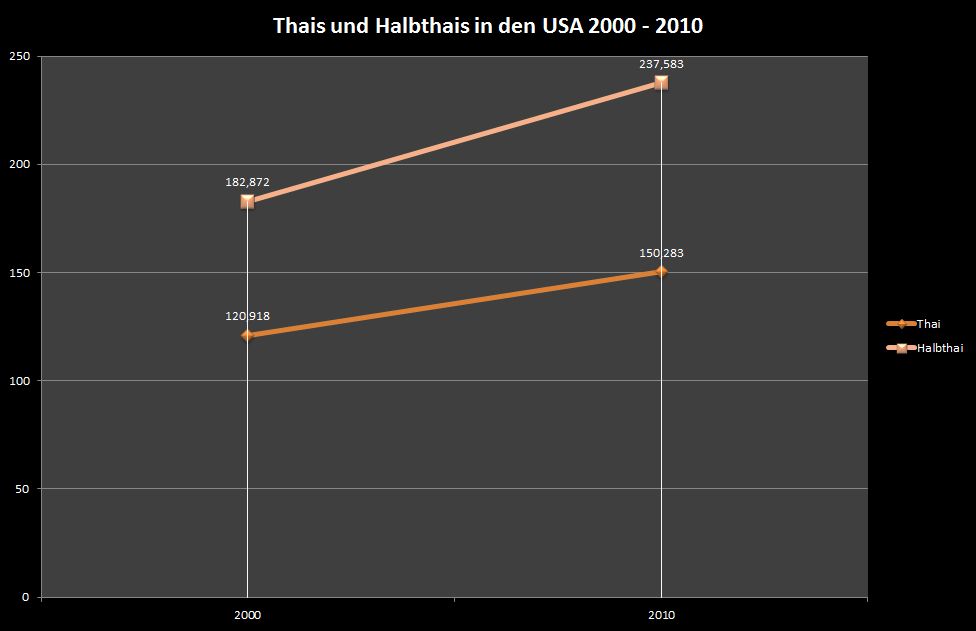
Abb.: Thais
und Halbthais in den USA 2000 - 2010
[Datenquelle: Census]
2010

An der Universität Hamburg erscheint die Master-Hausarbeit:
Hekele, Joscha: Die Sufficiency Economy : Fortschritt oder Rückschritt? Eine kulturwissenschaftliche und entwicklungsökonomische Analyse Thailands.
Der Verfasser kommt zu folgendem Ergebnis:
"Ziel dieser wissenschaftlichen Arbeit war es, das Konzept der Sufficiency Economy zu untersuchen. Es ist durch die Untersuchung klar geworden, dass es sich bei dem Konzept weniger um ein ökonomisches Konzept handelt. Vielmehr ist die Sufficiency Economy ein thailändischer Gesellschaftsentwurf, der starke kulturelle und moralische Züge enthält, die auf thailändischen und buddhistischen Werten aufbauen. Dieser Gesellschaftsentwurf ist ein Entwurf des Königs von Thailand. Inwieweit sich diese gesellschaftliche Idee als langlebig zeigen wird, bleibt offen. In jedem Fall ist es ein Gegenentwurf zu westlichen Gesellschaften. In dieser Arbeit wurde außerdem versucht, die ökonomische Essenz aus den Aussagen des Königs herauszuarbeiten. Dabei ist klar geworden, dass der König dem Handel kritisch gegenübersteht und dass die Sufficiency Economy in entwicklungspolitischer Betrachtung ein nach innen gerichtetes Konzept ist. Die Sufficiency Economy leitet sich ökonomisch von den Vorstellungen Schumachers ab, der eine lokale Ökonomie bevorzugte, die wenig in den internationalen Handel eingebunden ist. Ein weiterer wichtiger Punkt, der sich aus den Aussagen des Königs herauskristallisiert hat, ist die Forderung nach einer Grundversorgung der thailändischen Bevölkerung. Diese Tendenz der Sufficiency Economy zur Autarkie war der Gegenstand der empirischen Untersuchung dieser Arbeit. Mit Hilfe der Indikatoren SSR [Self-Sufficiency Ratio], IDR [Import Dependency Ratio] und TDI [Trade Dependence Index] wurde Thailands Stellung im regionalen Vergleich betrachtet und ausgewertet. Außerdem wurde aus den Indikatoren der SE-Index [Sufficiency Economy Index] formuliert und ebenfalls ausgewertet. Als Ergebnis hat sich letztendlich ergeben, dass Thailand im regionalen Vergleich im oberen Mittelfeld auf Platz drei liegt. Es lässt sich somit sagen, dass Thailand im regionalen Vergleich überdurchschnittlich autark ist. Die Untersuchung in dieser Arbeit bezieht sich allerdings nur auf die Situation in den Nahrungsmitteln und lässt prinzipiell keine Rückschlüsse auf andere Produktgruppen zu.
Was ist nun abschließend von der Sufficiency Economy als Entwicklungskonzept zu halten? Im Titel dieser Arbeit wird die Frage gestellt, ob Thailand mit diesem Konzept auf einem fortschrittlichen Wege ist. Der Autor ist der Meinung, dass das Konzept der Sufficiency Economy ökonomisch nicht viel mehr als eine Wiederholung alter Ideen ist. Protektionistische Einstellungen zum Handel sind keine Neuheit mehr, wie beispielsweise die Erfahrungen der lateinamerikanischen Länder in den 1960ern und 1970ern zeigen. Die ökonomischen Kosten sind zu hoch, um eine auf Selbstversorgung aufbauende, geschützte Ökonomie zu rechtfertigen. Handel ist ökonomisch betrachtet meist eine bessere Alternative, und gerade Thailand hat in der Vergangenheit davon profitieren können."
[a.a.O.]
2010
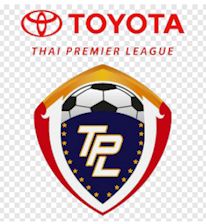
Sieger in der Thai Premier League (ไทยพรีเมียร์ลีก) (Fußball): Muangthong United F. C. (สโมสรฟุตบอล เมืองทอง ยูไนเต็ด)
Abb.: ®Logo
[Bildquelle: Wikipedia]
2010
Architekt Surachai Akekapobyotin [สุรชัย เอกภพโยธิน] (1970 - ) & Architektin Juthathip Techachumreon [จุฑาทิพย์ เตชะจำเริญ] von Office of AT: Fertigstellung des Hauses
L71 House, Bangkok
2010
Briefmarken:
ausführlich: http://www.payer.de/thailandchronik/ressourcen.htm
Zu Chronik 2010 / B. E. 2553. -- 2. Januar bis Juni